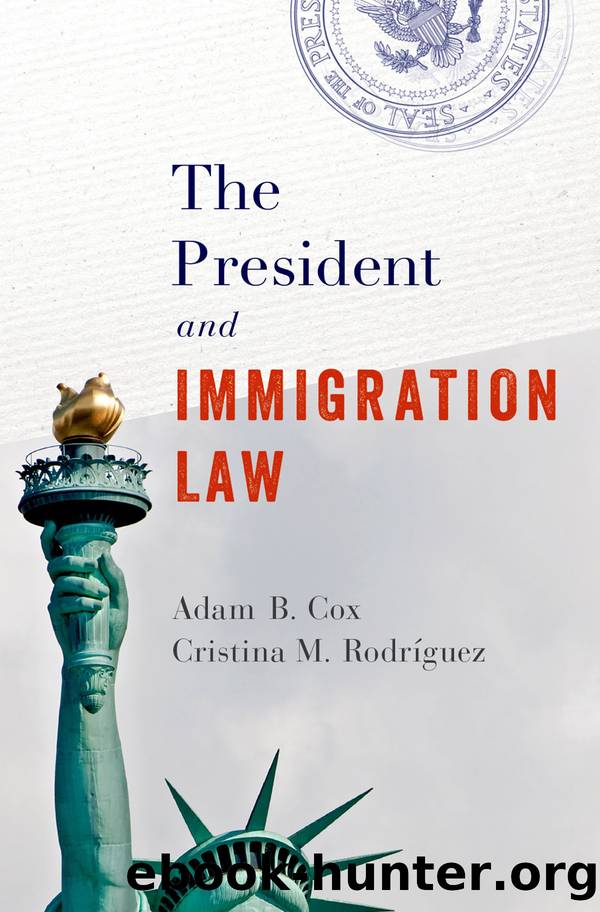The President and Immigration Law by Adam B. Cox

Author:Adam B. Cox
Language: eng
Format: epub
Publisher: Oxford University Press
Published: 2020-01-15T00:00:00+00:00
Beyond Forbearance
As with most government initiatives pursued in the realm of the possible, DACA had its limits, despite being transformative. While it promised recipients two years of forbearance from enforcement, along with the authorization to work in the United States, it did not promise the security of legal status. The authority to decline deportation does not entail the authority to alter the criteria for legal status that Congress has delineated. Secretary Napolitano herself disclaimed any idea that DACA gave rise to durable claims, noting in the programâs memoranda that they did not confer any âsubstantive right, immigration status or pathway to citizenship.â She wrote that âonly the Congress, acting through its legislative authority, can confer these rights.â95
But a close look at the INA suggests that the Secretary may have protested too much. The Code in fact contains tools the administration could have employed to put a significant number of unauthorized immigrants on the path to permanent legal statusâjust not those who were the beneficiaries of DACA. The foundation of this road not taken would have been the parole power, the bureaucratic case management device that various presidents of the twentieth century used to great effect to invent American refugee policy, in the series of moves we detailed in chapter 2. The fact that the Obama administration declined to pursue this more permanent course highlights the political high-wire act it believed itself to be performing, even with DACA. Not only would any sort of executive legalization strategy have inflamed Congress and other critics, it also would have left out the youth who epitomized the âdeserving immigrantsâ the President highlighted when making the moral case for immigration reform.
To see how a vigorous use of parole would have allowed President Obama to extend lasting relief to a significant portion of the unauthorized population, we must take a step back to immigration law basics. The INA long has made the spouses of US citizens eligible for green cards without subjecting them to the quotas and waiting periods that apply to many other family members eligible for status. The Center for American Progress estimates that approximately eight hundred thousand immigrants in the existing unauthorized population are currently married to US citizens and should therefore be eligible for legal status under the family preference provisions of the INA.96 But other features of the INA effectively preclude their applications for permanent residency. To secure the spousal visa, these immigrants would typically need to travel out of the country to an overseas consulate. But if they left the country, they would be barred from re-entering by an obscure provision of immigration law. That provision, added by Congress in 1996, bars anyone who has lived unlawfully in the United States for more than six months, and then departs, from re-entering the country for three or ten years (depending on the length of the personâs unlawful presence).97 In other words, leaving the country to pursue a green card would result in a long-term bar from reentering the country.
For many noncitizens
Download
This site does not store any files on its server. We only index and link to content provided by other sites. Please contact the content providers to delete copyright contents if any and email us, we'll remove relevant links or contents immediately.
| Antitrust | Civil Law |
| Emigration & Immigration | Federal Jurisdiction |
| Housing & Urban Development | Indigenous Peoples |
| Land Use | Public |
| Public Contract | Public Utilities |
| Urban, State & Local Government |
Machine Learning at Scale with H2O by Gregory Keys | David Whiting(4183)
Killers of the Flower Moon by David Grann(3969)
Oathbringer (The Stormlight Archive, Book 3) by Brandon Sanderson(2881)
Will by Will Smith(2793)
Once Upon a Broken Heart by Stephanie Garber(2670)
Guns, Germs and Steel by Diamond Jared(2303)
Borders by unknow(2229)
It Starts With Us (It Ends with Us #2) by Colleen Hoover(2198)
Friends, Lovers, and the Big Terrible Thing by Matthew Perry(2119)
The Room Where It Happened by John Bolton;(2103)
The Color of Law by Richard Rothstein(1885)
HBR's 10 Must Reads 2022 by Harvard Business Review(1777)
The Strength In Our Scars by Bianca Sparacino(1776)
A Short History of War by Jeremy Black(1762)
Water Rights and the Environment in the United States by John Burch(1643)
Examples & Explanations: Administrative Law by William F. Funk & Richard H. Seamon(1601)
515945210 by Unknown(1599)
A Game of Thrones (The Illustrated Edition) by George R. R. Martin(1589)
That Every Man Be Armed by Stephen P. Halbrook(1548)
